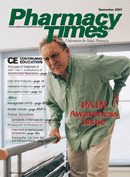Publication
Article
Pharmacy Times
A closer look at new FDA actions: Shire's Vyavanse
Author(s):
Ms. Domenici and Dr. Patel are both pharmacists at Brigham and Women's Hospital, Boston, Mass.
Shire?s VyvanseOn February 23, 2007, the FDAapproved Shire PLC?s lisdexamfetaminedimesylate (Vyvanse; formerlyknown as NRP 104) for the treatmentof attention deficit/hyperactivity disorder(ADHD) in children 6 to 12 years ofage.1 The US Drug Enforcement Agencyclassified Vyvanse as a schedule II controlledsubstance following recommendationsfrom the FDA on May 3,2007.1,2PharmacologyVyvanse is the first approved prodrugstimulant. The reason for its developmentwas that it provides a more consistentextended duration of effect andreduces the potential for abuse by eliminatingalternative-route administration(intranasal, intravenous), as well asreducing the potential for overdose.2Vyvanse is rapidly absorbed from thegastrointestinal tract and is convertedinto l-lysine, a natural amino acid, anddextroamphetamine, which is responsiblefor its activity.3
Dextroamphetamine is thought toblock the reuptake of dopamine andnorepinephrine. The mode by whichamphetamines exert their therapeuticeffect on ADHD is unknown. The conversionof Vyvanse to active dextroamphetamineis believed to occur viahepatic and/or first-pass intestinalmetabolism. Vyvanse is not metabolizedby CYP450 enzymes.
Approximately 96% of a 70-mgradioactive dose was found in the urineafter administration to 6 healthy patients.The plasma elimination half-lifeof Vyvanse typically averaged less than1 hour.3Clinical TrialsA phase 3 randomized, multicenter,double-blind, placebo-controlled, forced-doseparallel-group study was conductedto assess the tolerability andefficacy of Vyvanse in school-aged childrenwith ADHD, as compared withplacebo.4 A total of 290 female andmale children aged 6 to 12 years withADHD were randomly assigned toreceive Vyvanse 30 mg, 50 mg, and 70mg with forced-dose titration or placeboonce daily for 4 weeks. The ADHDRating Scale Version-IV (ADHD-RS), theConners? Parent Rating Scale-Revised(CPRS-R), and the Clinical GlobalImpression (CGI) of Improvement Scalewere all used to evaluate efficacy.The ADHD-RS total score from baselineto end point was improved by allgroups, compared with placebo (P<.001). Using the CPRS-R scoring in themorning, afternoon, and evening, theparents/guardians of the Vyvansegroup reported greater improvement insymptoms controlled throughout theday, compared with the parents/guardians of patients who receivedplacebo (P <.01). The greatest improvementswere seen in the 70-mggroup, compared with the placebogroup, at all time points. The CGI ratingswere either ?much improved? or?very much improved? in =70% of thepatients in the active-treatmentgroups, compared with 18% of the patientsreceiving placebo.4Precautions/ContraindicationsVyvanse is contraindicated in patientswith symptomatic cardiovascular disease,glaucoma, advanced arteriosclerosis,moderate-to-severe hypertension,or a known hypersensitivity tosympathomimetic amines. Patientswho have agitated states or a historyof drug abuse or were taking amonoamine-oxidase inhibitor withinthe past 14 days should not receiveVyvanse.3
It is recommended that growth bemonitored in individuals taking Vyvanse.Clinical evaluation of tics, Tourette?ssyndrome, and seizures should be performedbefore initiating Vyvanse, becausethese conditions may be exacerbatedwith the use of amphetamines.
The most common adverse effectsseen with Vyvanse treatment are decreasedappetite (39%) and insomnia(19%). Other adverse effects includeheadache, upper abdominal pain, irritability,nausea and vomiting, drymouth, and dizziness.3References
1. www.vyvanse.com/pressrelease.asp.
2. Vyvanse product information. Wayne, Pa: Shire Pharmaceuticals. May 2007.
3. Vyvanse package insert. Wayne, Pa: Shire US Inc. 2007.
4. Biederman J, Krishnan S, Zhang Y, McGough JJ, Findling RL. Efficacy and tolerability of lisdexamfetamine dimesylate (NRP104) in children with attention-deficit/hyperactivity disorder: a phase III, multicenter, randomized, double-blind, forced-dose, parallel-group study. Clinical Ther. 2007;29;450-463.







